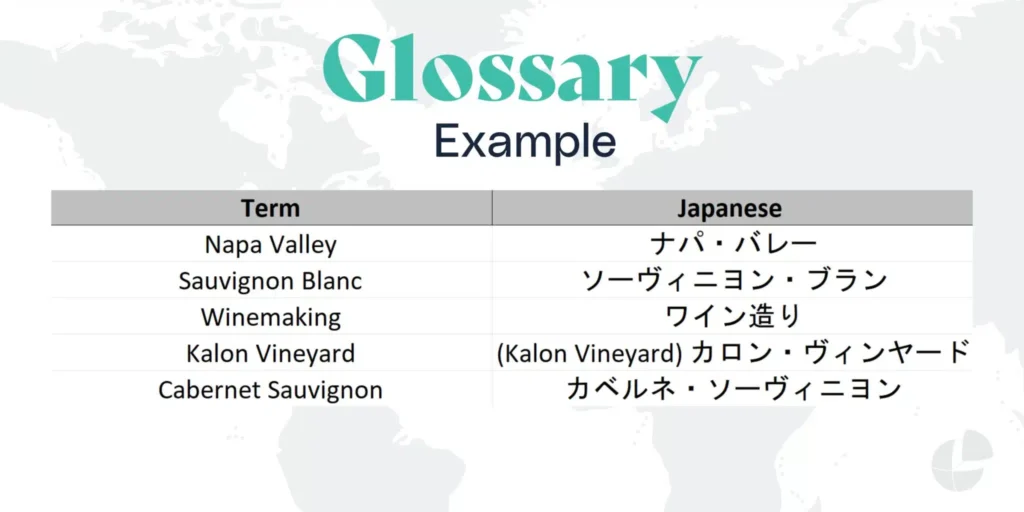
Learn the difference between a translation glossary and a translation style guide. Plus, determine if your business should consider developing these tools to improve your translation projects.
Topics covered in this article:
- Tools for Your Translation Team
- What is a Translation Style Guide?
- Key Benefits of a Multilingual Style Guide
- Examples Found in a Multilingual Style Guide
- What is a Translation Glossary?
- Key Benefits of a Translation Glossary
- Examples Found in a Translation Glossary
- Building Your Localization Tool Kit
Tools for Your Translation Team
Localization is a massive undertaking that, when done correctly, can expand your company’s reach—and bottom line. To improve the probability for success in localization, you may consider developing some common appropriate tools that many companies with consistent and ongoing translation work use.
The two most common tools can help make the translation process easier:
- a translation style guide (aka multilingual style guide or localization style guide), a blueprint that specifically defines how to translate your brand voice, tone, and language use.
- and a translation glossary (aka multilingual glossary), a way to store and organize specific terms for your translations.
Both are essential, contributing to the accuracy, coherence, and professionalism of translated materials. While they may seem similar, these tools serve distinct yet complementary purposes. Understanding their differences can help you understand the importance of each to achieve your goals.
What is a Translation Style Guide? (Maintaining Consistency and Creating Cohesion)
A multilingual style guide is like a blueprint for consistency across all localized content. It is a set of guidelines that creates cohesion between all content for each specific language. It ensures that your brand’s voice, tone and linguistic conventions remain intact. By providing clear guidelines on grammar, punctuation, capitalization, language usage, and overall writing style, a style guide helps your message resonate with your target audience.
Key Benefits of a Multilingual Style Guide
- Brand Consistency. A style guide establishes a unified brand identity across diverse markets. This consistent identity fosters trust and recognition among your various global audiences.
- Enhanced Communication. A style guide also helps deliver clear communication between your team and your localization partners. Reducing ambiguity and streamlining the localization process leads to smoother projects.
- Time Efficiency. A style guide can cut time spent on revisions and iterations of your projects. By setting clear parameters from the outset, you can speed the time-to-market for your localized content. This is true for any project, whether you’re publishing a website, writing a video script, or creating company collateral.
Examples Found in a Multilingual Style Guide
- Begin communications with a polite greeting, such as “您好” (nín hǎo) for formal settings or “你好” (nǐ hǎo) for informal contexts.
- Use informal language with the audience, such as “tú” instead of “usted,” to reflect the brand’s familiar personality.
- Use respectful and courteous language to show consideration and maintain a professional demeanor.
- Acknowledge and respect cultural differences, customs, and traditions, avoiding any potentially insensitive or offensive language.
- Use encouraging words to motivate and inspire, fostering a positive and uplifting atmosphere.
What is a Translation Glossary? (Navigating Linguistic Terrain)
A translation or multilingual glossary focuses on the translation of frequently used terms. It shares source language terms and their corresponding translations in the target language. This repository of approved translations provides the foundation for accuracy and consistency in target language writing. It helps avoid the risk of misunderstandings or mistranslations within your projects. A glossary standardizes the translation of terms and keeps your brand’s message consistent in any language.
Key Benefits of a Translation Glossary
- Precision and Accuracy. A translation glossary eliminates ambiguity, particularly in technical or specialized fields. It acts as a comprehensive reference for terms that may not have direct equivalents in the target language.
- Cultural Sensitivity. Outline localized terms and expressions that resonate with regional audiences.
- Cost-Efficiency. Reduce the likelihood of costly revisions by addressing translation challenges. Your linguistic team will have approved translations to reference improving their potential to get translations right the first time.
Examples Found in a Translation Glossary
- Source Language: English, Target Language: Chinese
- Term: “Network”
- Translation: “网络”
- Source Language: English, Target Language: Japanese
- Term: “Software”
- Translation: “ソフトウェア”
- Source Language: English, Target Language: Italian
- Term: “Server”
- Translation: “Server”
Building Your Localization Toolkit
So, which tool should you focus on first to improve your multilingual endeavors? The answer lies in your specific business objectives, target markets, and content requirements.
If brand identity is your top priority, invest in creating a style guide for translation. A style guide is critical for maintaining a consistent brand voice and identity across global markets. Similarly, if your content spans diverse formats and genres, a style guide can ensure cohesion and continuity across all mediums.
If your content involves complex terminology or industry-specific jargon, start with a translation glossary. A glossary will ensure accuracy and precision in translations no matter the language. A glossary may also be more immediately necessary if you operate in markets with distinct dialects or linguistic nuances.
Ready to get started or not sure which to choose? Interpro offers complimentary localization strategy sessions with our team of talented experts to help ensure you’re making the right decision every step of your translation journey.
Multilingual style guides and translation glossaries both are crucial tools for localization projects. While a style guide lays the foundation for consistency and coherence, a glossary guides your linguistic team with precision and accuracy. Each tool offers unique benefits that pave the way for global success.
Category: Translation
Tags: Guides
Service: Glossary Development, Style Guide Development, Translation Services
Don't forget to share this post!
Stay Updated with Interpro
Subscribe to our newsletter for the latest updates and insights in translation and localization.









